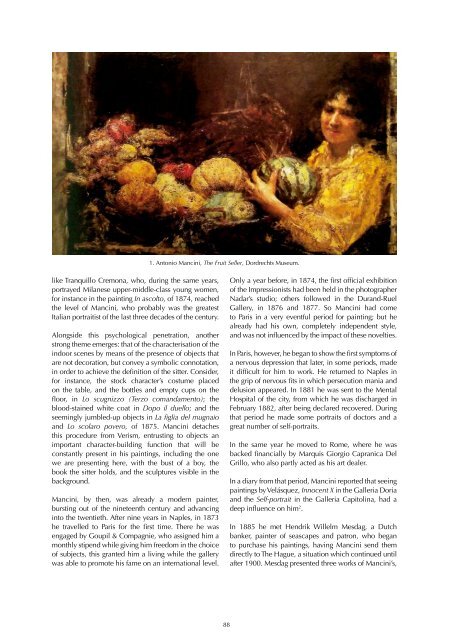You also want an ePaper? Increase the reach of your titles
YUMPU automatically turns print PDFs into web optimized ePapers that Google loves.
1. Antonio Mancini, The Fruit Seller, Dordrechts Museum.<br />
like Tranquillo Cremona, who, during the same years,<br />
portrayed Milanese upper-middle-class young women,<br />
for instance in the painting In ascolto, of 1874, reached<br />
the level of Mancini, who probably was the greatest<br />
Italian portraitist of the last three decades of the century.<br />
Alongside this psychological penetration, another<br />
strong theme emerges: that of the characterisation of the<br />
indoor scenes by means of the presence of objects that<br />
are not decoration, but convey a symbolic connotation,<br />
in order to achieve the definition of the sitter. Consider,<br />
for instance, the stock character’s costume placed<br />
on the table, and the bottles and empty cups on the<br />
floor, in Lo scugnizzo (Terzo comandamento); the<br />
blood-stained white coat in Dopo il duello; and the<br />
seemingly jumbled-up objects in La figlia del mugnaio<br />
and Lo scolaro povero, of 1875. Mancini detaches<br />
this procedure from Verism, entrusting to objects an<br />
important character-building function that will be<br />
constantly present in his paintings, including the one<br />
we are presenting here, with the bust of a boy, the<br />
book the sitter holds, and the sculptures visible in the<br />
background.<br />
Mancini, by then, was already a modern painter,<br />
bursting out of the nineteenth century and advancing<br />
into the twentieth. After nine years in Naples, in 1873<br />
he travelled to Paris for the first time. There he was<br />
engaged by Goupil & Compagnie, who assigned him a<br />
monthly stipend while giving him freedom in the choice<br />
of subjects, this granted him a living while the gallery<br />
was able to promote his fame on an international level.<br />
Only a year before, in 1874, the first official exhibition<br />
of the Impressionists had been held in the photographer<br />
Nadar’s studio; others followed in the Durand-Ruel<br />
Gallery, in 1876 and 1877. So Mancini had come<br />
to Paris in a very eventful period for painting; but he<br />
already had his own, completely independent style,<br />
and was not influenced by the impact of these novelties.<br />
In Paris, however, he began to show the first symptoms of<br />
a nervous depression that later, in some periods, made<br />
it difficult for him to work. He returned to Naples in<br />
the grip of nervous fits in which persecution mania and<br />
delusion appeared. In 1881 he was sent to the Mental<br />
Hospital of the city, from which he was discharged in<br />
February 1882, after being declared recovered. During<br />
that period he made some portraits of doctors and a<br />
great number of self-portraits.<br />
In the same year he moved to Rome, where he was<br />
backed financially by Marquis Giorgio Capranica Del<br />
Grillo, who also partly acted as his art dealer.<br />
In a diary from that period, Mancini reported that seeing<br />
paintings by Velásquez, Innocent X in the Galleria Doria<br />
and the Self-portrait in the Galleria Capitolina, had a<br />
deep influence on him 2 .<br />
In 1885 he met Hendrik Willelm Mesdag, a Dutch<br />
banker, painter of seascapes and patron, who began<br />
to purchase his paintings, having Mancini send them<br />
directly to The Hague, a situation which continued until<br />
after 1900. Mesdag presented three works of Mancini’s,<br />
88
















